Design for design’s sake.
The BMW GS line (GS is German for what we now call ‘dual purpose’) is not only one of the most famous and long-lived motorcycle designs, it also saved BMW from abandoning motorcycle manufacture when introduced in 1980. The idea was to craft a bike as capable on tarmac as it was on an unpaved forest road and the line continues to this day with aggregate production exceeding half a million. That’s a lot for a bike.
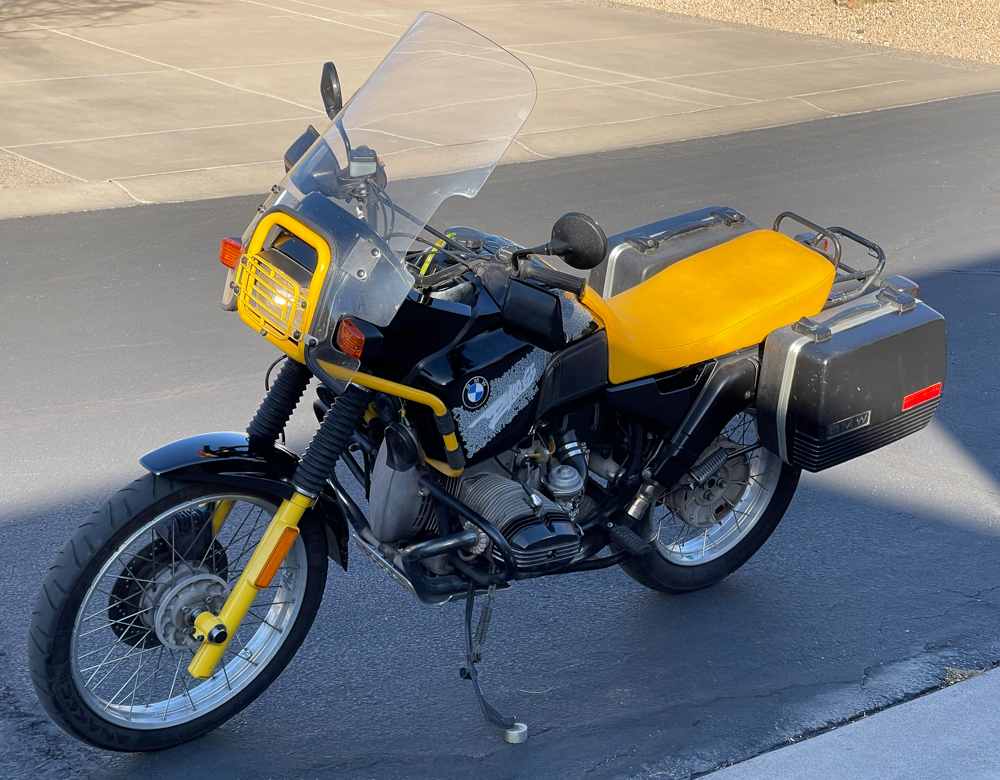
My 1992 R100GSPD. Awful aftermarket Parabellum windshield fitted.
The ‘Bumblebee’ color scheme is the one you want.
And the idea took off. It was something new after a long run of high quality but largely identical motorcycles from BMW, more known for their use by police forces worldwide than for exciting exploits off road. BMW pushed the idea by entering one in the Paris-Dakar rally which it handily won and the GSPD variant was born, with a gargantuan 9.25 gallon plastic gas tank. The airhead motor – meaning the trusty, horizontally opposed, air cooled twin – had grown to 1000ccs from the original’s 800, and was putting out a decent 60 horses or so, more than adequate for anything encountered in the real world.
So knowing that I needed a summer project in the furnace-like heat of southern Arizona, and also knowing that my garage would be air conditioned and the very lap of wrenching luxury before the heat arrived, I snapped up a lightly used GSPD from a fellow member of the BMW Motorcycle Owners of America. A decent lot, generally of trustworthy mien. The owner of many years was giving up riding at age 82 and was happy to pass it down to this sprightly 69 year old piker, along with more accessories and spares than you could shake a stick at. Thank you, Chuck in San Diego. I would tell you the cost but it’s not nice seeing grown men (or even women) weep, but when all the extras are disposed of it was pretty close to free. Such is luck. I’ll probably sell it in a year or so. I prefer the older machines.
The immediate and obvious things that had to be done was to send off the speedometer/odometer to Rick Borth at Overseas Speedometer to have the mileage adjusted to the correct 40.9k. BMW hit a bad spell in the ’90s with failing odometers and the certificate of speedometer change which came with the bike testified to its having been replaced with a new instrument in 1994, meaning that the reading on the replacement instrument was wrong, a fact calculated to drive any rational rider up the wall. Rick reset the mileage to the correct reading and generally looked the instrument over, fixing anything else which ailed it. Not least of the adjustments made was to correct the under-reading of speed, a common failing of that era’s Airheads. The speedometer was reading 15% low. Now it’s correct, calibrated using a known speed trap in Scottsdale which keeps the police in doughnuts.
Second, the bike came with both Jesse metal panniers and stock BMW plastic ones. The Jesses are just the ticket if you want to ride across some hell hole like Kazakhstan, though quite why any sane person would want to do that defeats me. They are also known to be nuclear war proof. Suffice it to say that they were in mint condition and after removal and replacement with the stock bags – shown above – the Jesses are for sale for a very tidy sum, for they are no longer available from the manufacturer, and very rarely to be found in any condition, let alone mint.
Third, the shockingly bad aftermarket Parabellum windshield had to go, especially as the bike also came with the factory original, twice as robust and thrice as competent. The Parabellum is so poorly engineered that no matter how you adjust it, you can be sure that the sides will strike the tank as the handlebars are canted over. The maker even admits to this on its web site. Hullo! And it was when refitting the stock shield that I realized just how much thought had gone into the design of the mounting hardware.
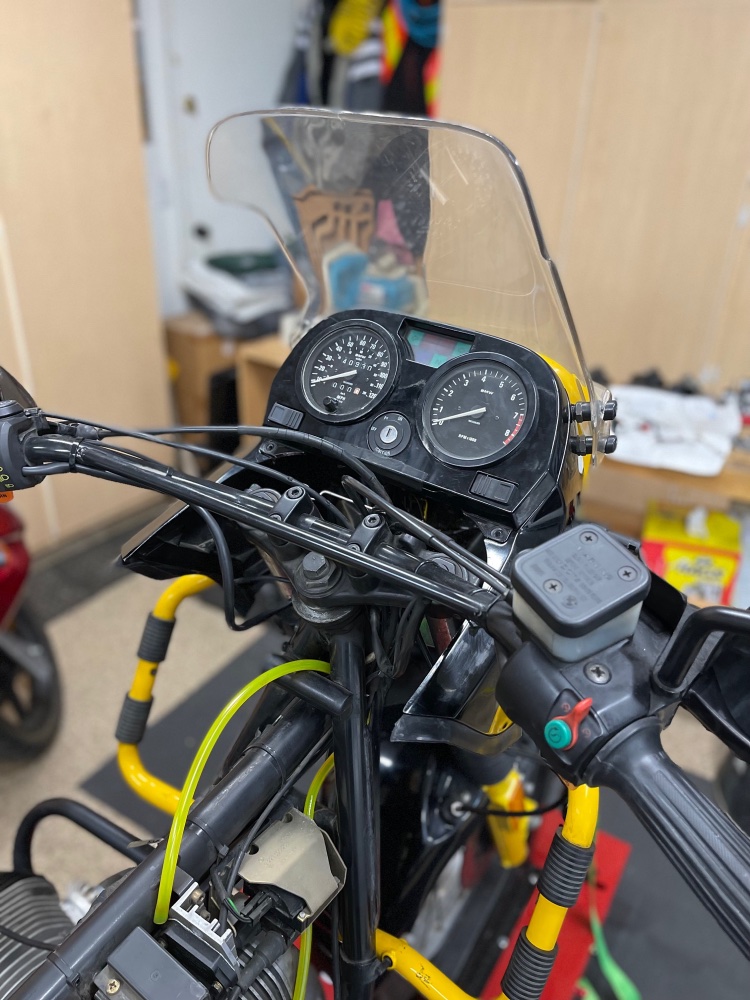
With the stock windshield. Odometer recalibrated.
I had removed the fairing sides when installing LED warning lights and gauge lighting, so the first step was to install the sides using the stock compound bolts which are center drilled and tapped for attachment of the windshield. Needless to say these are of unequal length, the longer of each pair going in the top attachment point. Now BMW had decided that the tilt of the stock shield should be easily adjusted, so they came up with a pivot hole and slot opening design, seen here:
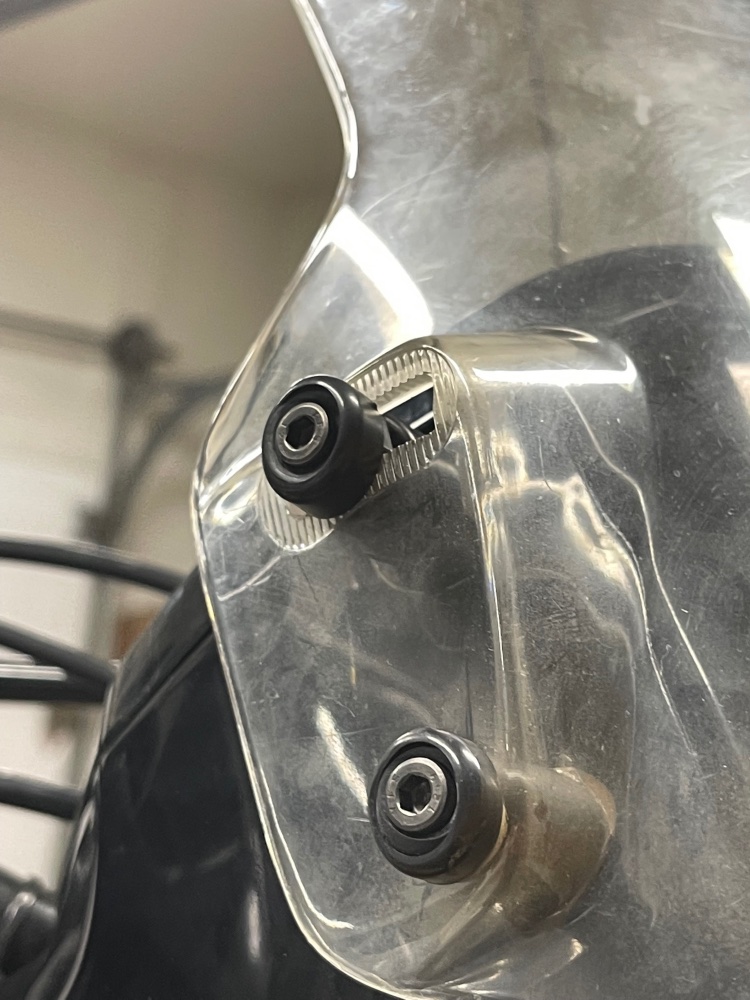
The pivoting mechanism for the stock windshield.
So what, you ask? A couple of Allen bolts and spacers, no big deal. Wrong! The spacers, both inner and outer, are canted to adjust to the angle of the windshield. They also differ, the lower having a small spigot to allow the outer spacer to engage just so in the correct orientation, with the inner female threaded spacer having a square surround to properly align with the outer part, also being canted. The upper is also complex, this time with a wider spigot and castings on both the inner and outer parts and when you install the whole thing correctly you can adjust the angle of the windshield – clickety-click – by loosening both Allen bolts and having at it. Fear not, the interlocking mechanisms will see to it that nothing falls apart or becomes misaligned. So there you have great design, if insanely complex. And some smart German engineer poured his heart into the math and production dictates of these seemingly innocuous parts so that they would work just so and continue to function properly for 100,000 miles or more. And that, I suppose, is why my motorcycle of choice is the BMW Airhead.
Other fixes? You can see the alloy puck. the previous owner had attached to the foot of the sidestand in the first image, above. This reduces the lean angle with the machine on the sidestand where the heavy, large fuel tank makes the bike want to tip over. Sadly, as with all Airheads since the mid-1980s, BMW makes it extremely difficult to deploy the sidestand from the saddle as it cannot be seen. So I removed the puck, drilled a transverse hole and epoxied a steel rod in the hole as an extension for the left foot, thus:
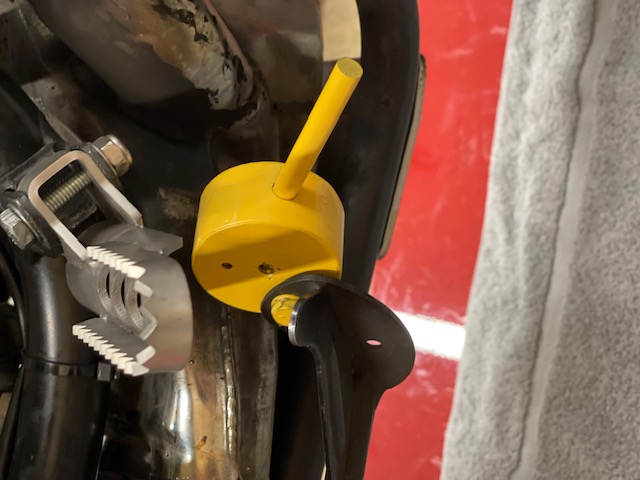
Puck deployment extension – the whole thing painted a jolly yellow to match the color scheme.
There’s lots left to do. As with all Airheads drive to the rear hub is by shaft, no chains here, and the dual universal joints fitted to the shaft – dictated by the anti-torque design of the rear suspension – are known weak points, frequently failing without warning at 40,000 miles. My machine is at 40,900 …. Removal and inspection is no big deal and the aftermarket Airhead community is so robust that much improved designs with proper Zerk grease fitting can be had for peace of mind – and piece of wallet. Then there’s the panoply of odds and sods to be attended to which is normal for a bike of this age, but nothing to lose sleep over.
And I will be doing that work here:
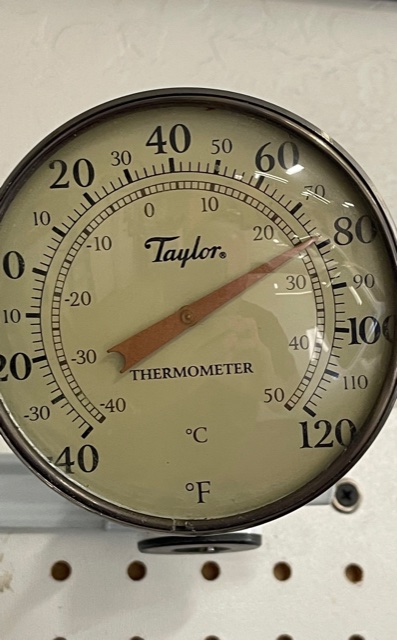
Inside the air conditioned garage. It’s a toasty 100F outside.